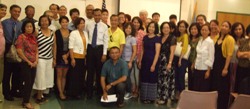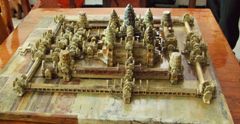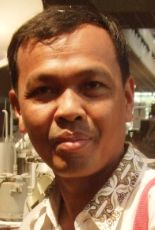By Ben Bao, edited by Pichchenda Bao Plasencia.
Lakhon Khol is a traditional Cambodian theater performance. The word "Lakhon" refers to a theatrical drama. The word “Khol” means something short and curvy, according to Reverent Chuon Nath’s dictionary published by Buddhist Institute of Cambodia in 1967, page 102. It may be derived from another Khmer word “Khel” meaning shield. Putting the two words together, Lakhon Khol is a masked dance drama. According to George Cedes, a French researcher, in his study published in “Annale de l’URBA No 1 in 1967, page 157, he defines Lakhon Khol as “Dances of the Great Monkeys”. Regardless of what is the possible meaning of Lakhon Khol, one should know that it is a dance drama about the human, monkey, and ogre.
Lakhon Khol has existed since the
Glorious Angkor era (802 - 1431). It is believed to have been performed when the Khmer capital was at Kulen Mountain. During Cambodia’s
dark age (1431 -1863), Cambodia nearly lost this heritage.
Lakhon Khol reappeared in the 20th century during King Sisowath’s reign and continued on through King Norodom Sihanouk’s reign after the end of World War II. In 1948, King Sihanouk visited the Vegetable History at Wat Svay Andet in Kandal Province, where a Lakhol Khol was performed in a yearly ritual ceremony to ask the gods for rainfall and peace to the community. His visit at Wat Svay Andet and the performance of Lakhon Khol was published in Soriya journal by the Duke of Krosem Kuntheak Bondit, March 3, 1948, 3rd edition. In 1954 after gaining independence from France, Cambodia erected a statue of Hanuman around the area of Samdach Sang Chuon Nath’s statue. It has been lost, cause unknown. Only the statute of Samdach Chuon Nath still remains.
On November 28, 2018, Lakhon Khol of Wat Svay Andet was included in the List of Intangible Cultural Heritage in Need of Urgent Safeguarding of UNESCO.
Lakhon Khol is similar to other Khmer classical dances or Royal Ballet dances with two notable exceptions:
1) Historically, it was performed by an all-male cast. Presently, some changes have been made to allow female dancers as well.
2) The theatrical dance drama only portrays various episodes of the
Khmer Reamker, the Khmer legend of the Ramayana.
The typical performance of Lakhon Khol includes an introduction of the storytellers in form of narration and dialogue, followed by dances with choreography similar to the Royal Ballet dance. However, the hand, foot, and body gestures are emotionally true to the story of the Khmer Reamker. Classical Khmer music called Pinpeat is an essential part of the dance. The classical dances use the same Pinpeat music, but they tend to be long. Pinpeat music for Lakhon Khol sometimes is short and transitions quickly from one song to the next based on the gestures and movements of the performers in the story. Drums are also used in between narration and dialogue. For instance, an angry gesture is normally followed by drumming.
How Lakhon Khol started and why its performers were all male are a mystery. Many researchers believe that Lakhon Khol is a form of Khmer traditional entertainment that grew out of frustration with the exclusionary traditional Royal Ballet and classical dances. Commoners never had a chance to see the Royal Ballet and classical dances which were created for the pleasure of the royal families and the elites only. So, the commoners created their own version of the dances to serve their needs. But why were they all male dancers?
There are two schools of thought that are dominant in Cambodian society. The first explanation is based on the historical fact that classical dances were part of religious rituals during the Angkor era when Cambodians practiced Hinduism as their religion. They used female dancers (even for male characters) as a means to communicate with Hindu gods. The classical dances existed even before Cambodia believed in Deva Reachea, a Hindu mythology, a belief that a king is the king of gods. After the reign of Javarman II, the belief in Deva Reachea intensified. The female dancers were called godly celestial servants, practically the king’s messengers to the gods. According to a book in Khmer language, the Khmer Performing Arts published by the Cambodian National Assembly in 2003, page 124-127, there were as many as 615 dancers at Prasat Taprom, and there were as many as 1,000 dancers at Prasat Preah Khan. The dances requested a blessing from the gods for various purposes, such as a good harvest season, to end a drought, to have victory over their enemies, to have peace and harmony in the nation, etc. Mahayana Buddhism spread to Cambodia in the later years of the Angkor era causing great conflict. The dances that had been dedicated to Hindu gods were now dedicated to the Buddhas. The practice of Mahayana Buddhism was in full swing during Jayavarman VII. The female dancers who danced at Hindu temples transitioned to dance at Buddhist temples. The female dancers gradually became courtesan ladies, and many elites and high ranked government officials fooled around with them. The elites, mostly the Hindu followers, wanted to defame Buddhist followers, mostly commoners. They started courting the female dancers at the royal palace for their own pleasure just to show Buddhist followers (like the dancers) were not a good people. That upset the Buddhist believers, predominantly commoners. The religious conflicts continued, and the commoners created their own version of dance, an all-male dance drama to prevent corrupt government officials from courting the dancers. Thus, the birth of Lakhon Khol.
The second explanation has something to do with the changing of the royal family from Varman to Trasak PaEm. Trasak PaEm (literally means sweet melon) was a melon farmer. Unlike other farmers, his melon was very tasty and sweet. People had known him as Grandpa Trasak PaEm. He lived among commoners and enjoyed watching various dances that commoners created. He himself may have created some dances. His sweet melon and his interest in the performing arts for the commoners made him famous in the country. He had no royal blood. One day, he brought his sweet melons to the royal palace and offered them to the king who liked them a lot. The king ordered him not sell the sweet melon to anyone except the royal family. He also gave Trasak PaEm a spear that only the high rank musketeers used. The king did not trust Trasak PaEm and wanted to test out to see if he followed his orders. One night, the king and his secret guards snuck into Trasak PaEm’s farm. While he was watching a show at the village, Trasak PaEm noticed someone was sneaking into his farm to steal his melons. He must guard the melon or the king would punish him. He rushed to the farm and saw many men armed with weapons. He threw the spear at one of the men. Unfortunately, that man was the king, killing him instantly. The king left no heir. Throughout history, Cambodia has had no firm rule of succession. Many kings were themselves usurpers. Cambodians at that time thought the famous Trask PaEm, as they knew him, was a powerful man who could kill a powerful king, even though it had been by chance. They made him king. King Trasak PaEm was a good Buddhist follower. He was also known as a clever person. The religious conflict between Hinduism and Buddhism continued during his reign. He attempted to resolve the conflict. He ordered his dance masters to create a new dance that only performed the very well-known story, the Khmer Reamker. In order to circumvent the practice of elites taking dancers as their lovers, the dancers must be male and hide their face, thus the masks. This new dance would please both Buddhist and Hindu followers. It should be noted that the practice of some aspects of Hinduism continues today, but to a much lesser degree. In addition, Cambodians tend to attribute Hindu practices to Buddhist mythologies.
Cambodian all-male dances are not singular in the world. Such dances exist in other countries. In India, it is called “KATHAKALI” and has been in existence 1000 years ago. In Japan, similar dance exists for many centuries. It is called”KABUKI”. Despite the two explanations given, the original creation of Lakhon Khol still remains a mystery. Nobody knows.
Source of references:
https://en.wikipedia.org/wiki/Lakhon_Khol
Book of “Khmer Performing Arts” by Research Committee on Arts and Culture, published by the Cambodian National Assembly, 2003, page 124-141.








